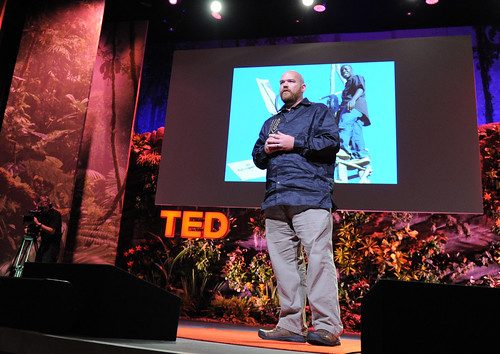Erik Hersman, onstage Thursday at TEDGlobal. Photo: James Duncan Davidson / TED
On Wednesday, July 13, a bombing in Mumbai took at least 10 lives. At TEDGlobal, the TED Blog talked with Erik Hersman, one of the cofounders of Ushahidi, an online crisis mapping and response tool — as a new Ushahidi deploys today to react to the bombings. As Hersman says: “This is a very rare moment to see all this stuff happening in real time.”
Hersman walked us through how an Ushahidi is born. The main Ushahidi for the Mumbai bombings was set up by Ajay Kumar (follow him @ajuonline). “He’s a veteran Ushahidi deployer in India,” Hersman said. “There was another early crowdmap, done by Anand Giridharadas (follow him at @AnandWrites), who’s a columnist for the New York Times and International Herald Tribune, but he collapsed his and sent everyone to Ajay’s. It’s so easy to set up an Ushahidi now that anybody can do it, so you have to coordinate which one’s going to be the main one.”
So how does it begin?
First, a Skype chat is set up for volunteers, added person by person, and that’s going right now — they’re doing everything from there. They do a couple different things to start. One is to run a live online updates list. They’re tracking media hits, setting up Twitter hashtags, things to follow. Some of this is people-curated and some of it’s automated.
And then the volunteers decide what to do with this information. There’s a Google spreadsheet — right now, there’s so much traffic they’ve made it a simple spreadsheet — and it lists everything: Who to call for help, blood bank needs, a bunch of different types of information … what everyone’s Twitter handles are …
Tell me about your role as a co-founder of Ushahidi?
It’s all about the volunteers. What we do is backstop in the beginning, but then these guys are the ones that do the work. Maybe we coordinate a little for the community stuff, because we’ve done it before, but we just get them working with each other and then back off.
There are volunteers coming together from all over the world now. Hundreds — and it looks like they have the crisis mappers network on it now. The Standby Crisis Mappers Task Force is a volunteer group of over 500 people from all over the world — that’s why there’s so many people.

Comments (2)
Pingback: Shonali Burke Consulting, Inc. | Weekly Roundup: What's Buzzing?
Pingback: Nothing. Everything.